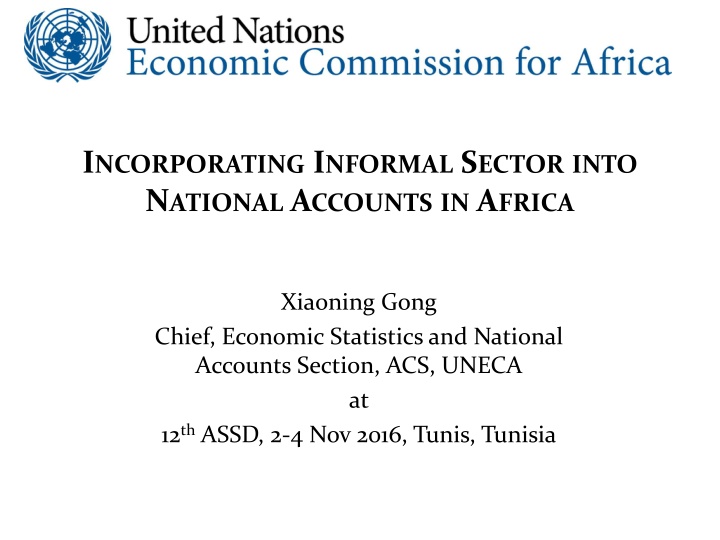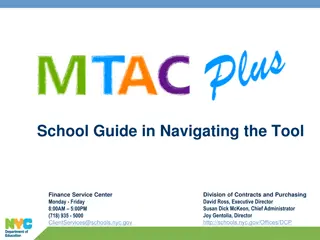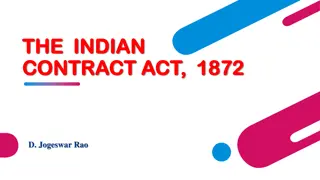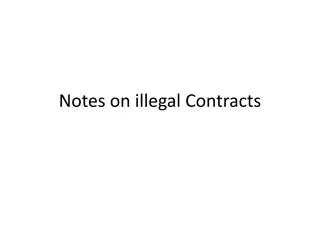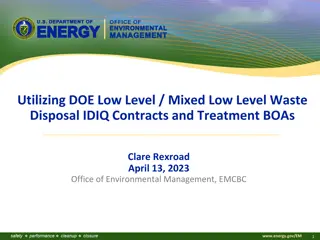Contracts in Business
A contract is an agreement between parties enforceable by law, encompassing terms, conditions, scope of work, leases, and more. Learn about when contracts are needed, insurance requirements, and selecting the right contract type.
Download Presentation

Please find below an Image/Link to download the presentation.
The content on the website is provided AS IS for your information and personal use only. It may not be sold, licensed, or shared on other websites without obtaining consent from the author.If you encounter any issues during the download, it is possible that the publisher has removed the file from their server.
You are allowed to download the files provided on this website for personal or commercial use, subject to the condition that they are used lawfully. All files are the property of their respective owners.
The content on the website is provided AS IS for your information and personal use only. It may not be sold, licensed, or shared on other websites without obtaining consent from the author.
E N D
Presentation Transcript
INCORPORATING INFORMAL SECTORINTO NATIONAL ACCOUNTSIN AFRICA Xiaoning Gong Chief, Economic Statistics and National Accounts Section, ACS, UNECA at 12thASSD, 2-4 Nov 2016, Tunis, Tunisia
Outline of the Presentation The role of informal sector in the African economies Data collection (types of surveys) Data processing (use of data from surveys and censuses) Data compilation (measuring informal sector) Country case studies: Experience and practice of Africa Regional-wide efforts: harmonized questionnaire & exchange and of methodology Summary and conclusions Economic Commission for Africa www.uneca.org
Share of Informal Employment (%) Regions/Countries/Years Northern Africa Algeria 1990-94 1995-99 2000-04 2005-10 47.5 42.7 47.3 41.3 53.0 45.6 Morocco 44.8 67.1 78.5 Tunisia 47.1 35.0 36.8 Egypt 55.2 78.1 45.9 51.2 70.0 96.3 The Rest of Africa 76.0 92.9 Benin Burkina Faso 77.0 78.4 90.5 Cameroon 84.0 Chad 74.2 95.2 Cote d Ivoire 69.7 Dem. Rep. Congo (ex-Zaire) 77.0 Ghana 65.3 Guinea 71.9 86.7 Kenya 70.1 71.6 76.8
Share of Informal Employment (%) (Contd) Regions/Countries/Years 1990-94 1995-99 2000-04 2005-10 The Rest of Africa 76.0 78.1 70.0 Lesotho Liberia Madagascar Mali Mauritania Mozambique Namibia Niger Nigeria Senegal South Africa Tanzania Uganda Zambia Zimbabwe 70.7 56.4 73.7 90.4 94.1 82.7 73.5 87.2 43.8 42.9 46.2 57.7 32.7 46.0 73.5 76.3 58.3 51.6
Share of Informal Sector Value Added Informal sector GVA (excluding agriculture) in % of non- agricultural GVA Informal sector GVA (including agriculture) in % of total GDP Informal sector GVA (excluding agriculture) in % of total GDP Countries (years) Africa (except Northern Africa region) 63.6% 50.2% 31.3% Middle East North Africa 36.2% 29.2% 26.2% India 54.2% 46.3% 38.4% Latin America 29.2% 25.2% 24.0% Transition countries 19.5% 13.9% 10.7%
Data Collection: Types of Surveys Northern Africa Western Africa Central Africa Eastern Africa Southern Africa Types of Surveys Africa Mixed surveys (1-2 or 1-2-3) 1 6 4 2 13 Mixed surveys (others) 1 1 3 4 9 Combined surveys 1 1 2 Establishment censuses and surveys 4 9 2 1 16 LSMS type surveys 6 1 2 2 11 Labor force surveys 4 2 3 8 17 Total number of countries 4 14 6 4 12 40
Data Processing: Use of Data from Surveys and Censuses Observations of experience in Africa - Mixed survey approach: most popular in Africa (14 countries) - Establishment-based approach: second most popular; often taken with a census; - Combined survey approach: Household survey + establishment survey - Other approach Economic Commission for Africa www.uneca.org
Data Compilation: Measuring Informal Sector Direct survey approach vs. indirect approach - To use indirect approaches for the measurement of the informal sector regardless the existence of direct survey data or not Incorporating informal sector into national accounts - Mixed (household/establishment) and combined (household + establishment) are preferred method - Various surveys are used as data sources (Chart 1 in the document) SUTs and IOT - Major tools for the compilation of national accounts in that they ensure the consistency of the data obtained from various sources and various approaches - ERETES used by 22 countries (11 of 24 countries use it effectively). Economic Commission for Africa www.uneca.org
Scheme of Labor Input Matrix and Data Sources Industries Hotels-rest Ser to HHs Transport Ser to ent Finance Finance Mining Manuf Admin Const Trade Sources Total Agr Population Census (A) or Labour force survey (B) or Other household survey (C) Total employment by industries and by employment status (self- employed/paid employees), in full-time equivalent (1) Other sources for formal employment: survey of formal enterprises ; social security registers; Other Paid employment in full-time equivalent and formal employers (2) Total employment (self-employed and paid employees) in unincorporated enterprises with less than 5 employees (3) Total employment in incorporated enterprises and in unincorporated enterprises with 5 and more employees (4) Establishment Census (or Economic Census) Total employment by industries and by employment status (1) Employment in informal sector (household survey) (5) Employment in informal sector (enterprise survey) (6) Mixed or combined household/establishment survey (D) Traditional residual Better residual (1) (2) (1) (4) (1) - (4) = (6) + (5 6) + (1 5) (4) Informal employment = informal employment in informal enterprises + informal employment in formal sector + informal employment in unincorporated enterprises of production for own final use Informal employment by component Economic Commission for Africa www.uneca.org
Country Case Studies: Experience and Practice in Africa 1-2-3 surveys - DRC and Senegal Labor input matrix - Burkina Faso - Cameroon - Madagascar Household surveys - Burundi (Living Cond of HH) - Egypt (HH Inc & Exp) - Ghana (Living Stand) - Lesotho (HH Budget) - Mozambique (HH Budget) - Nigeria (Living Stand) - Zimbabwe (HH Inc & Exp) Other approach - Mauritius - Seychelles - South Africa Economic Commission for Africa www.uneca.org
Continental-wide Efforts: Harmonized Questionnaire and Exchange of Methodology Training workshops and seminars for capacity building. African Group on Informal Sector (AGIS) and African Group on National Accounts (AGNA) to bring countries together to work in this area. Compiling a guidebook to operationalize the international statistical standards and recommendations and to share of country practical experience. Designing harmonized questionnaires and related manual for the 1-2 survey on the continent. Expert Group meetings on the standardized questionnaires and on the methodologic operational guidebook. Regular progress reports and updates of the practice used by countries to the StatCom-Africa and CoDGs. Economic Commission for Africa www.uneca.org
Criteria for Identifying Informal Sector Criteria Objective Since 15th ICLS - 1. Legal organization: unincorporated businesses as separate legal entity of the owners 2. Ownership : business created and run by members of households 3. Type of accounting: no complete accounting system that includes balance sheets 4. Destination of production : at least some of the tradable products Identification of unincorporated businesses - Identification of unincorporated family or individual businesses 15th ICLS - - Exclusion of quasi- unincorporated family enterprise businesses 15th ICLS SNA 2008 - Identification of unincorporated family or individual businesses producing tradable goods and services; Exclusion of unincorporated family or individual businesses producing goods exclusively for own household use SNA 2008 Economic Commission for Africa www.uneca.org
Criteria for Identifying Informal Employment Operationally, in the production units (formal and informal) and in households, employees are considered as having informal jobs if at least one of the following conditions has not been met: payment of social security protection allowance by the employer; paid sick leave; paid annual leave or compensation in lieu. Economic Commission for Africa www.uneca.org
Criteria for Identifying Informal Employment (cont d) Criteria 5. Type economic activity Exclusion of households employing paid domestic workers Objective Since 17th ICLS - Possible exclusion of enterprises engaged in agriculture and related activities - - 6.1 Number of persons engaged/employees/perman ent employees less than n and/or Identification of informal sector business as a sub-group of unincorporated family or individual business producing tradable goods and services 17th ICLS SNA 2008 6.2 Non registration of the business and/or 6.2 Non registration of the employees of the business Economic Commission for Africa www.uneca.org
Summary and Conclusions Informal sector plays a very important role in African economies. Mixed survey (i.e. 1-2 survey) is most preferable. Labor input matrix is recommended to be compiled. To finalize the standardized questionnaire for the mixed survey: (a) screening questions to identify informal sector and (b) proper questions to survey on the informal sector. Training workshops and seminars, expert group meetings for exchanging and sharing of methodology, continuing the compilation of a practical operational guidebook, and further assisting and supporting countries to follow up. Economic Commission for Africa www.uneca.org
Summary and Conclusions (Contd) Recommendations of best practice - Mixed surveys and combined surveys should be privileged and systematically implemented because they provide national accountants with full set of indicators - To build labor input matrix along with SUT to overcome the problem of data gaps due to a lack of all necessary surveys in both demand and production sides Economic Commission for Africa www.uneca.org
Thank you for your attention!
